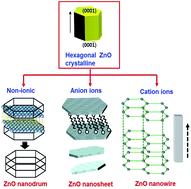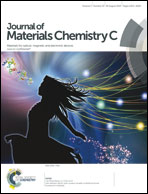Synthesis of hexagonal ZnO nanodrums, nanosheets and nanowires by the ionic effect during the growth of hexagonal ZnO crystals
Abstract
A hexagonal ZnO crystal has six nonpolar (10![[1 with combining macron]](https://www.rsc.org/images/entities/char_0031_0304.gif) 0) prismatic faces that are capped by a polar Zn-terminated (0001) face or an O-terminated (000
0) prismatic faces that are capped by a polar Zn-terminated (0001) face or an O-terminated (000![[1 with combining macron]](https://www.rsc.org/images/entities/char_0031_0304.gif) ) face. The growth of a certain surface can be impeded by additives which preferentially adsorb onto specific crystal surfaces. By adding nonionic surfactants, anions and cations to a hexagonal ZnO precursor solution, we can synthesize hexagonal ZnO nanodrums, nanosheets and nanowires. The ZnO nanodrums are produced with a nonionic surfactant which forms a lamellar micelle structure in the solution. Hexagonal ZnO nanosheets were produced in the solution containing anions, which inhibited crystal growth in the c-axis direction, whereas the cations accelerated the c-axis crystal growth to produce ZnO nanowires. Thus, we could control the ZnO shape by controlling the ionic effect in the hexagonal ZnO crystalline precursor solution. When the ZnO nanostructures were applied to the photovoltaic devices, the ZnO nanowire solar cell shows the highest cell performance, which is the ideal structure to improve the performance of the photovoltaic devices.
) face. The growth of a certain surface can be impeded by additives which preferentially adsorb onto specific crystal surfaces. By adding nonionic surfactants, anions and cations to a hexagonal ZnO precursor solution, we can synthesize hexagonal ZnO nanodrums, nanosheets and nanowires. The ZnO nanodrums are produced with a nonionic surfactant which forms a lamellar micelle structure in the solution. Hexagonal ZnO nanosheets were produced in the solution containing anions, which inhibited crystal growth in the c-axis direction, whereas the cations accelerated the c-axis crystal growth to produce ZnO nanowires. Thus, we could control the ZnO shape by controlling the ionic effect in the hexagonal ZnO crystalline precursor solution. When the ZnO nanostructures were applied to the photovoltaic devices, the ZnO nanowire solar cell shows the highest cell performance, which is the ideal structure to improve the performance of the photovoltaic devices.


 Please wait while we load your content...
Please wait while we load your content...